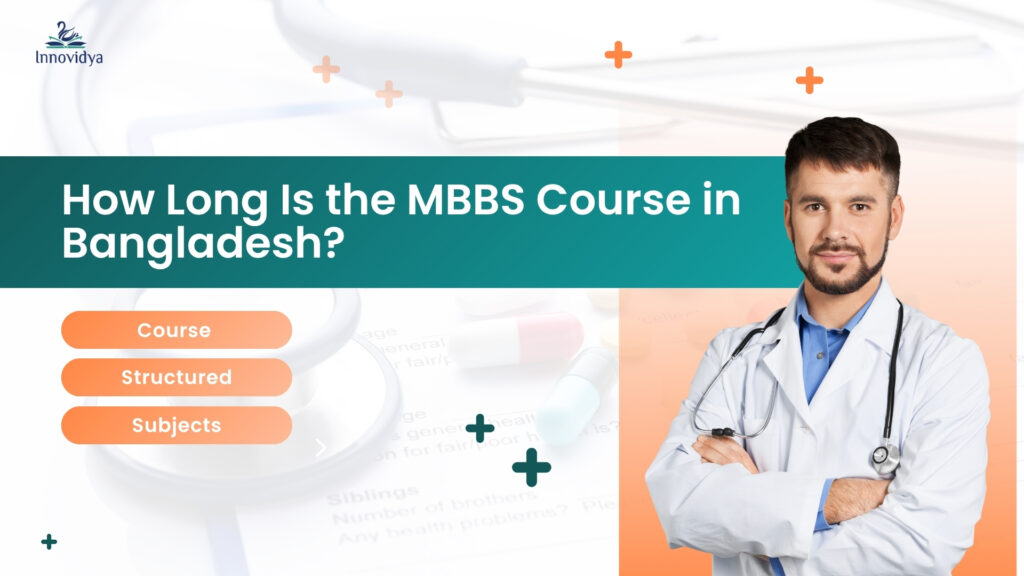
The MBBS degree in Bangladesh takes 5 years of academic study, plus a 1-year compulsory rotatory internship in a hospital. That internship helps you get hands-on experience and is usually done in Bangladesh itself, but for Indian students, it’s often optional, so you can also complete it back home.
So in total, it’s a 6-year journey from admission to doctor.
For Indian students, that internship can usually be done in Bangladesh or even back home if you prefer. So in total, you’re looking at 6 years to complete your medical degree.
Great question! The course is split into four phases, each focusing on different subjects that build on one another. Each phase is divided into semesters, and each semester is about 6 months long. Here’s a quick overview:
Phase 1 (1.5 years)
Anatomy
Physiology
Biochemistry
This is all about building a solid foundation in the basic sciences.
Phase 2 (1 year)
Community Medicine
Forensic Medicine
This is where you start understanding medicine’s impact on society and the legal system.
Phase 3 (1 year)
Pharmacology & Therapeutics
Pathology
Microbiology
You’ll learn about how drugs work, how diseases develop, and all the bugs that cause them.
Phase 4 (1.5 years)
Medicine & Allied Subjects (like Pediatrics, Psychiatry, Dermatology)
Surgery & Allied Subjects (Orthopedics, ENT, Ophthalmology, Anesthesiology)
Obstetrics & Gynaecology
This is when you move into the clinical world, seeing patients and working in hospitals.
All told, you’ll tackle around 19-20 core subjects—a mix of theory and practical work—covering everything from the human body to diseases and treatments. Here’s a rough breakdown:
Pre-clinical Subjects:
Anatomy, Physiology, Biochemistry
Para-clinical Subjects:
Pathology, Microbiology, Pharmacology, Community Medicine, Forensic Medicine
Clinical Subjects:
Medicine, Surgery, Pediatrics, Obstetrics & Gynaecology, ENT, Ophthalmology, and more
The aim is to make you a well-rounded doctor who can handle any medical situation.
Exams happen every six months or so, with a mix of written tests, oral exams, and practicals. Don’t worry—it’s not just about memorizing facts. The assessments focus on your understanding and your ability to apply what you’ve learned in real-life situations.
Affordable Tuition: The fees are generally lower than in private colleges in India or in countries like China or Russia.
English Medium: Classes are taught in English, so no language barrier.
Recognized Degree: The MBBS degree is accepted by the WHO, NMC/MCI (India), BMDC, and many others.
Great Clinical Training: You’ll get lots of patient interaction and hands-on experience, which is super important for becoming a good doctor.
Is an MBBS from Bangladesh recognized in India?
Yes, it is! You’ll need to clear the FMGE (Foreign Medical Graduates Exam) or NEXT (once that comes in) to practice back home.
Is there an entrance exam for admission?
Usually not. Admissions are based on your high school marks in Biology, Chemistry, and Physics. Some colleges might ask for an interview.
Is Bangladesh safe for students?
Absolutely. It’s a friendly country, and most colleges offer good hostel facilities and support services.
If you’re dreaming of becoming a doctor, studying MBBS in Bangladesh is definitely worth considering. It’s affordable, high-quality, and very similar to what you’d get in India—without breaking the bank.
Got questions about admission, eligibility, or choosing the right college? Feel free to reach out anytime. I’m here to help!

Quick Links
Home
About Us
What We Do
MBBS in Abroad
MBBS in Bangladesh
Colleges
Contact Us